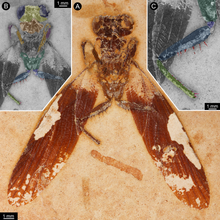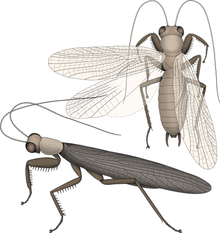Santanmantis
| Santanmantis Temporal range:
| |
|---|---|

| |
| Specimen MB.I.2068 | |

| |
| Life restoration (Note: the spines on the second set of legs have been considered questionable by other authors) | |
| Scientific classification | |
| Domain: | Eukaryota |
| Kingdom: | Animalia |
| Phylum: | Arthropoda |
| Class: | Insecta |
| Order: | Mantodea |
| Family: | †Santanmantidae Grimaldi 2003 |
| Genus: | †Santanmantis Grimaldi, 2003 |
| Species: | †S. axelrodi
|
| Binomial name | |
| †Santanmantis axelrodi Grimaldi, 2003
| |
Santanmantis is an extinct genus of
mantises, the sole genus in the family Santanmantidae. The only species, Santanmantis axelrodi , is known from the Crato Formation of Brazil, dating to the late Aptian stage of the Early Cretaceous.[1][2][3] It is amongst the most primitive known lineages of mantis.[4] Like other mantises, the forelegs are modified into spined raptorial appendages. When describing a new specimen in 2017, Hörnig, Haug and Haug proposed that the second set of legs also had spines similar to the forelegs, and also served a raptorial function, but that they were not visible in the fossil due to being broken off.[5] However a response to this paper criticised this assumption, finding that it had little evidence from the fossil itself or from living mantises.[6]
References
- ^ "Santanmantis". GBIF. Retrieved 2019-05-11.
- ^ "The Paleobiology Database, genus Santanmantis". Retrieved 2019-05-11.
- ^ Otte, Daniel; Spearman, Lauren; Stiewe, Martin B. D. (2019). "genus Santanmantis Grimaldi, 2003". Mantodea species file online, Version 5.0. Retrieved 2019-05-11.
- S2CID 231391397.
- PMID 28761789.
- PMID 29158979.
